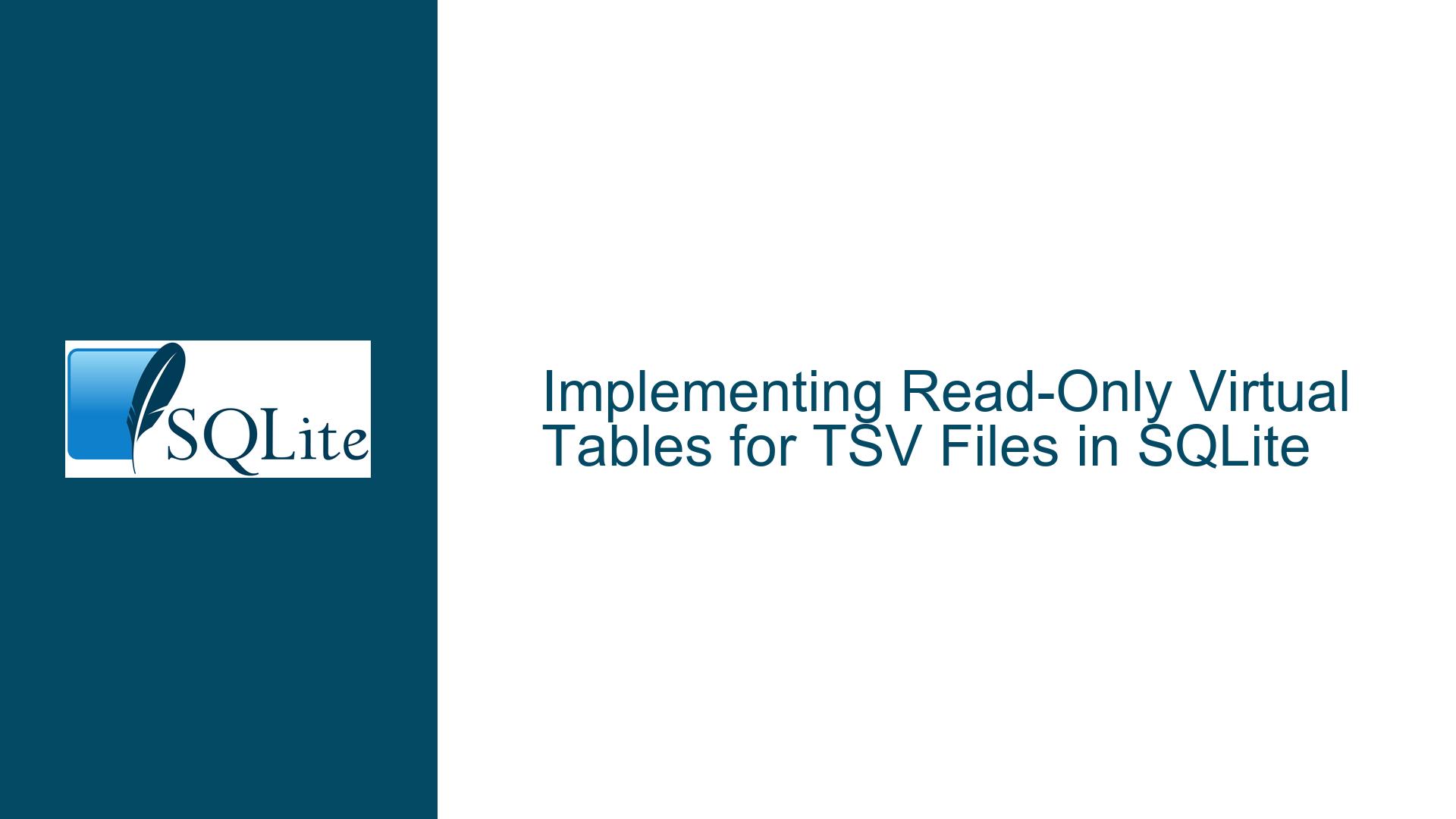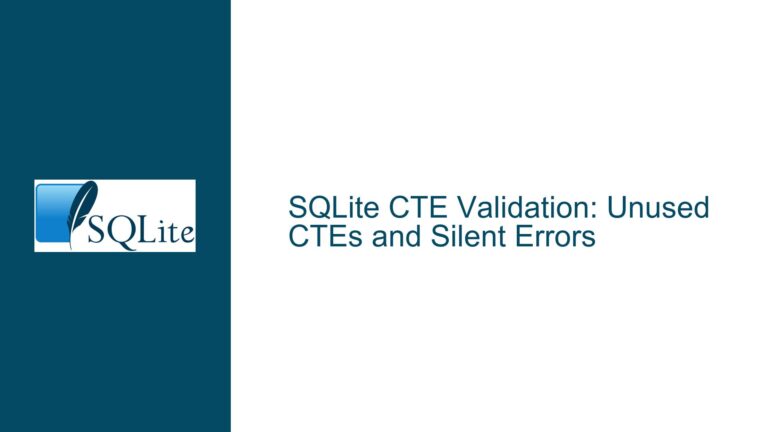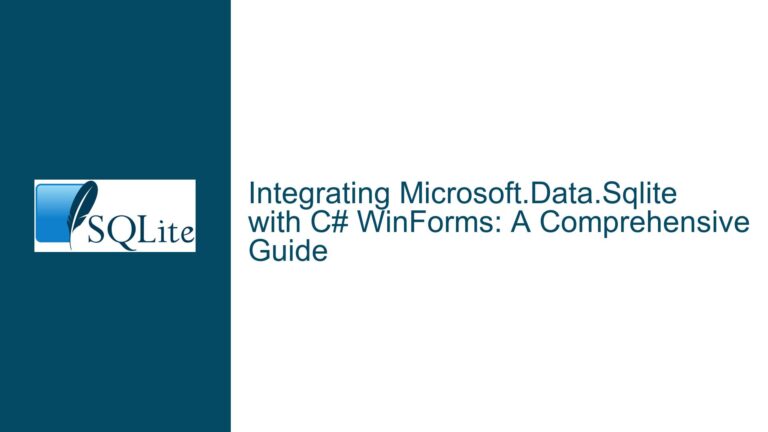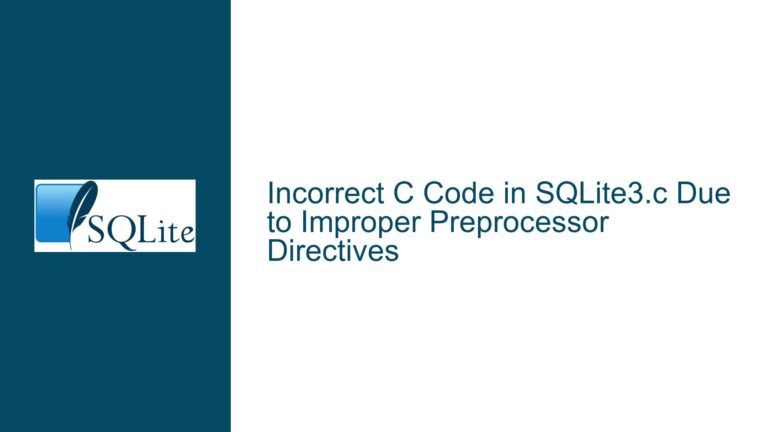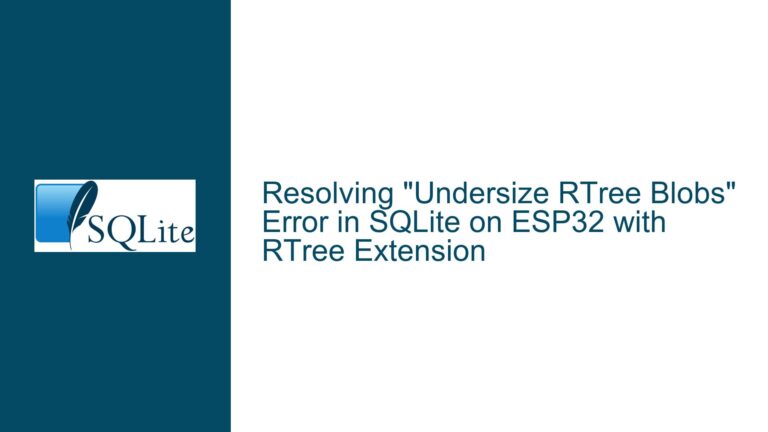Implementing Read-Only Virtual Tables for TSV Files in SQLite
Virtual Table Column Requirements at Creation Time
When implementing a virtual table in SQLite to provide read-only access to large files containing rows of tab-separated key-value pairs, one of the primary challenges is the requirement to define all column names at the time of virtual table creation. This requirement stems from SQLite’s internal mechanisms, which rely on the schema of the virtual table to execute the query planner effectively. The query planner is responsible for optimizing SQL queries, and without a predefined schema, SQLite cannot accurately predict the structure of the data it will be working with.
The necessity to define column names upfront is a limitation that can complicate the implementation of virtual tables, especially when dealing with files where the column names might not be known in advance or could vary between different files. This limitation is not unique to TSV files but is a general constraint in SQLite’s virtual table mechanism. The virtual table module must construct a "CREATE TABLE" statement that SQLite uses to understand the expected data structure when interacting with the virtual table callbacks.
This requirement can be particularly cumbersome in scenarios where the schema of the TSV files is dynamic or not known until runtime. For instance, if the TSV files are generated by different systems or processes, the column names might differ, making it challenging to create a one-size-fits-all virtual table implementation. The need to define columns at creation time means that any flexibility in handling varying schemas must be built into the virtual table implementation itself, rather than relying on SQLite’s native capabilities.
Schema Discovery and Dynamic Column Handling in Virtual Tables
One of the primary causes of the limitation in defining column names at virtual table creation time is SQLite’s reliance on a fixed schema for query planning and execution. SQLite’s query planner needs to know the number of columns and their names to optimize queries effectively. This requirement is particularly evident in the implementation of virtual tables, where the schema must be explicitly defined before any data access can occur.
In the context of TSV files, this limitation can be mitigated by implementing a schema discovery mechanism that reads the first line of the TSV file to determine the column names. This approach is similar to how some CSV virtual table implementations operate, where the first line of the CSV file is treated as the header row containing the column names. By reading the first line of the TSV file, the virtual table implementation can dynamically determine the schema and construct the necessary "CREATE TABLE" statement at runtime.
However, this approach introduces its own set of challenges. For instance, reading the first line of the TSV file to determine the column names requires that the file is accessible and readable at the time of virtual table creation. This might not always be feasible, especially in environments where the TSV files are large or located on remote storage systems. Additionally, handling files with varying schemas requires careful consideration of how to map the dynamically discovered columns to the virtual table’s schema.
Another potential cause of issues in virtual table implementations is the handling of extra columns or values that are not part of the predefined schema. In some cases, it might be desirable to discard columns and values that are not recognized or to map them into an "extras" column as key-value pairs. This approach can provide flexibility in handling varying schemas but requires additional logic in the virtual table implementation to manage these extra columns effectively.
Leveraging Schema Creators and Implementing PRAGMA journal_mode
To address the challenges of defining column names at virtual table creation time and handling dynamic schemas, one effective solution is to leverage existing schema creation technology. If a schema creator is already available that can read through TSV files and generate a schema, this technology can be integrated into the virtual table implementation. By using the schema creator to determine the column names at runtime, the virtual table can dynamically construct the necessary "CREATE TABLE" statement and provide read-only access to the TSV file.
In addition to leveraging schema creators, implementing PRAGMA journal_mode can help ensure data integrity and improve performance when working with virtual tables. PRAGMA journal_mode controls how SQLite handles the journal file, which is used to implement atomic commit and rollback. By setting the journal mode to WAL (Write-Ahead Logging), the virtual table implementation can achieve better concurrency and performance, especially when dealing with large TSV files.
Another important consideration is the handling of schema changes in the TSV files. If the schema of the TSV files changes over time, the virtual table implementation must be able to adapt to these changes. One approach is to make the virtual table implementation aware of ‘SET variables’ that can provide default values for new fields in the target table that are not present in the saved TSV file. This approach allows the virtual table to handle schema changes gracefully and ensures that the data remains consistent even as the schema evolves.
To summarize, implementing a read-only virtual table for TSV files in SQLite requires careful consideration of the limitations and challenges associated with defining column names at creation time. By leveraging schema creators, implementing PRAGMA journal_mode, and handling schema changes effectively, it is possible to create a robust and flexible virtual table implementation that can provide read-only access to large TSV files with varying schemas.
Detailed Troubleshooting Steps and Solutions
Step 1: Schema Discovery and Dynamic Column Handling
The first step in implementing a read-only virtual table for TSV files is to develop a schema discovery mechanism that can read the first line of the TSV file to determine the column names. This mechanism should be integrated into the virtual table implementation to dynamically construct the necessary "CREATE TABLE" statement at runtime. The following steps outline the process:
Open the TSV File: The virtual table implementation should open the TSV file and read the first line to determine the column names. This can be done using standard file I/O operations in the programming language used to implement the virtual table.
Parse the Header Row: The first line of the TSV file should be parsed to extract the column names. This can be done by splitting the line on the tab character and storing the resulting column names in an array or list.
Construct the CREATE TABLE Statement: Using the extracted column names, the virtual table implementation should construct a "CREATE TABLE" statement that defines the schema of the virtual table. This statement should be executed by SQLite to create the virtual table.
Handle Extra Columns: If the TSV file contains columns that are not part of the predefined schema, the virtual table implementation should handle these extra columns appropriately. This can be done by discarding unrecognized columns or mapping them into an "extras" column as key-value pairs.
Step 2: Leveraging Schema Creators
If a schema creator is already available that can read through TSV files and generate a schema, this technology should be leveraged to simplify the virtual table implementation. The following steps outline the process:
Integrate the Schema Creator: The schema creator should be integrated into the virtual table implementation to automatically determine the column names at runtime. This can be done by calling the schema creator’s API or library functions from within the virtual table implementation.
Generate the Schema: The schema creator should be used to generate the schema for the TSV file. This schema should include the column names and data types, which can then be used to construct the "CREATE TABLE" statement.
Create the Virtual Table: Using the generated schema, the virtual table implementation should construct and execute the "CREATE TABLE" statement to create the virtual table in SQLite.
Step 3: Implementing PRAGMA journal_mode
To ensure data integrity and improve performance, the virtual table implementation should set the PRAGMA journal_mode to WAL (Write-Ahead Logging). The following steps outline the process:
Set the Journal Mode: The virtual table implementation should execute the following SQL statement to set the journal mode to WAL:
PRAGMA journal_mode=WAL;This statement should be executed after the virtual table is created but before any data access occurs.
Verify the Journal Mode: The virtual table implementation should verify that the journal mode has been set to WAL by executing the following SQL statement:
PRAGMA journal_mode;This statement will return the current journal mode, which should be "wal" if the setting was successful.
Handle Journal Mode Errors: If the journal mode cannot be set to WAL, the virtual table implementation should handle the error appropriately. This might involve falling back to a different journal mode or notifying the user of the issue.
Step 4: Handling Schema Changes
To handle schema changes in the TSV files, the virtual table implementation should be made aware of ‘SET variables’ that can provide default values for new fields in the target table that are not present in the saved TSV file. The following steps outline the process:
Define SET Variables: The virtual table implementation should define a set of variables that can provide default values for new fields. These variables should be configurable and can be set by the user or application using the virtual table.
Apply Default Values: When reading data from the TSV file, the virtual table implementation should check for new fields that are not part of the predefined schema. If a new field is found, the implementation should apply the default value from the corresponding SET variable.
Update the Schema: If the schema of the TSV file changes significantly, the virtual table implementation should update the schema accordingly. This might involve recreating the virtual table with the new schema or dynamically altering the existing schema.
Step 5: Testing and Validation
The final step in implementing a read-only virtual table for TSV files is to thoroughly test and validate the implementation. The following steps outline the process:
Test with Various TSV Files: The virtual table implementation should be tested with a variety of TSV files, including files with different schemas, large files, and files with extra columns. This will help ensure that the implementation can handle a wide range of scenarios.
Validate Data Integrity: The virtual table implementation should be validated to ensure that the data read from the TSV file is accurate and consistent. This can be done by comparing the data read by the virtual table with the original TSV file.
Performance Testing: The virtual table implementation should be tested for performance, especially when dealing with large TSV files. This will help identify any performance bottlenecks and ensure that the implementation can handle large datasets efficiently.
Error Handling: The virtual table implementation should be tested for error handling, including scenarios where the TSV file is inaccessible, the schema changes unexpectedly, or the journal mode cannot be set to WAL. This will help ensure that the implementation can handle errors gracefully and provide meaningful error messages to the user.
By following these detailed troubleshooting steps and solutions, it is possible to implement a robust and flexible read-only virtual table for TSV files in SQLite. This implementation will provide efficient and reliable access to large TSV files with varying schemas, while ensuring data integrity and performance.
